
|
Sale 113
The Manuscript and Collectibles Auction
| Lot |
Photo |
Description |
Realized |
Lot 789 |
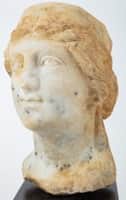 |
Fine Greco-Roman Marble Head of a Goddess, Possibly Tyche/Fortuna, ca 1st-2nd Century AD. Portrait of a goddess, her hair centrally parted and braided, with hair drawn and tied in a bun. She wears a cylindrical flat-top headdress, perhaps unfinished, or was finished in stucco and/or paint in antiquity which is now lost. The eyes, nose, and delicate smile make this marble bust wonderfully expressive.
Fine crystalline white marble. Close examination reveals expert, museum quality restoration to left check. Otherwise a wonderful bust. On a black wooden base.
Height: 9". Estimated Value $3,500 - UP
Antiquities, Museum of the World Treasures, Kansas City.
View details and enlarged photo
Realized
$3,000 |
|
Lot 790 |
 |
Important Egyptian Wooden Coffin of the Lady Ta-Khnum-iw; Ptolemaic Period and Complete Cartonnage Sections with Inscriptions. The completeness of this superb archeological find ranks this anthropoid sarcophagus and cartonnage as one of the most attractive and desirable of the Ptolemaic Period. This example is heavy in text of the three main ancient Egyptian languages: Hieroglyphs, Demotic and Hieratic.
Moderate conservation in selected areas, overall well preserved with original vivid polychrome pigmentation throughout. (Photos of the conservation before and after available.)
As researched by Edmund S. Meltzer PHD., the lot comprises a wooden coffin and lid (Length: 5'5", 160 cm; Width 15", 38 cm; Height 13", 33 cm) showing the face of a woman and very partially preserved inscription and decoration and four sections of cartonnage with inscriptions and polychrome decoration as follows:
Mask/head covering, Height: 12¼", 31 cm; Width 8", 20 cm.
A collar with pectoral, Width: 15", 30¾ cm.
A large panel or leg covering, Length: 23", 58 cm; Width: 8½", 22cm.
A foot covering, Height: 11½", 29 cm.
Both iconographic and inscriptional criteria indicate a date in the Ptolemaic through early Roman period, ca. 300 BCE through the 1st Century CE. Iconographic parallels to individual features will be referred to below; a good parallel to the overall iconography can be seen in a wrapped mummy in the Michael C. Carlos Museum at Emory University, dating to the Ptolemaic period (Gay Robins, The Art of Ancient Egypt, Cambridge, MA: Harvard Univ. Press 1997, p. 250, fig. 302)
The inscriptions are characteristic of objects of this kind in the Greco-Roman period. The hieroglyphic texts are fairly standard, but there are writings not encountered in classical hieroglyphic texts of the Pharaonic period. On the whole the texts are capably executed, but occasionally the scribe/copyist has which seem to be superfluous or redundant (especially the letter "n") while in other cases a grammatical ending or word is omitted. In the case of omitted grammatical endings (especially the feminine ending -t), the omission reflects the obsolescence of that ending in the language spoken at the time. As previously mentioned, the language includes all three of the Egyptian scripts: hieroglyphs, hieratic, and demotic. The latter two are cursive scripts; demotic belongs exclusively to the Late and Greco-Roman periods from 7th Century BC through the 5th Century CE. In both of the cursive scripts, the paleography or style of writing is a dating criterion, and both the hieratic and demotic sign forms on the present assemblage are consistent with the Ptolemaic and early Roman period. The hieratic sign forms have been collected and arranged chronologically in Georg Möller, Hieratisch Palaographie Vol. III (Lepzig: Hinrichs 1912), a standard reference work, and the writings of the demotic words with forms typical of different periods can be found in Wolja Erichsen, Demotisches Glossar (Copenhagen: Ejnar Munksgaard, 1954). It can be noted that the name of the filiation of the person for whom the coffin and cartonnage were made are given in all three scripts.
The Mask/Head Covering
The mask contains no inscriptions except for the captions labeling the goddesses Isis and Nephthys. The iconography is very significant.
The gilded color of the face is frequently encountered in mortuary objects; compare also earlier gold funerary masks such as the very famous one of Tutankhamen and the somewhat later one of General Wen-djebau-en-djed from Tanis (which can be found in Müeller and Thiem's, Gold of the Pharaohs NY, Barnes and Noble, 2005). Gold was considered as the flesh of the gods, as well as the color of the sun. This coloring expresses the transformation of the person into a divine being, who is reborn like the glowing sun. For comments on mummification and its rituals and accompaniments as transformation into a god, see E. S. Meltzer, "Reflection on Egypt and Alchemy II: The Alchemy of Mummification, Discussions in Egyptology 53 (2002) 57-65.
On examples with this type of decoration, the mouth is often not shown with any outline or pigment see, for example, Christie's catalogue NY Antiquities 9 December 2005, lot 84, p. 42. Note the modeling of the nose and mouth is simplified and not detailed. The motive for not having such details is likely the imitation or appearance of a pure gold mask.
The top of the head features a winged scarab, which is also found on the large cartonnage section. The winged scarab represents the rising sun personified by the god Khepri, signifying the beginning and renewal of the solar cycle and the process of rebirth = resurrection. The winged scarab is also a form of the triumphant god Horus in the Myth of Horus at Edfu.
The back of the head shows two goddesses labeled Isis (left) and Nephthys (right) supporting/embracing a Djed-pillar, which signifies "stability" and is an amulet specifically associated with Osiris. Here it stands for the figure of Osiris, who is mourned for and protected by the two goddesses and typically appears between them. Above the Djed-pillar is a hawk, which can represent the falcon Horus, the avenging son of Osiris and Isis. In the posture in which the hawk is represented, it also resembles Isis herself as a kite, the form she took to conceive Horus from the reconstituted body of Osiris.
COLLAR WITH PECTORAL
The pectoral is a piece of jewelry that can be worn on or suspended from a collar or necklace and that sits on the chest. The pectoral in this example is shaped like a shrine topped with a common architectural element called a "cavetto cornice". It contains a group of four seated deities with captions reading from right to left: "Recitation by Osiris, the Great God, Ruler of Eternity" "Horus", "Isis" and "Nephthys"
LARGE CARTONNAGE SECTION/LEG COVERING
This is a large and complicated section, with a number of inscriptional and iconographic elements. The entire panel comprises three horizontal registers going all the way across, plus three more horizontal registers divided in half (into two panels apiece) by a vertical column of hieroglyphs. The layout and content of this section corresponds very closely with the Michael C. Carlos Museum example even to the series of iconographic elements as they proceed from top to bottom.
Upper Register: Winged scarab with sun-disk above the wings are 10 short columns of hieroglyphs reading from right to left, a solar invocation addressing the sun-god "Hail to you, Re-Harakhty, Great God, Lord of Heaven, Dappled of Plumage Who comes forth from the horizon that he may give radiance to Nut."
Below the wings are two supine mummiform figures labeled at the head with what appears as the signs for "East" and "West"; thus the register portrays the entire solar cycle. The two mummiform figures also invite comparison with the two divine corpses of Re and Osiris which can be found in the Underworld. There is a short line of demotic a the foot of each figure giving the name and parentage of the person buried in the coffin.
Right: "Ta-Khnum-iw" (Personal name). Left: "Born (?) of the mother Ta-Sopdet"
Second Register Down: Eleven short vertical columns of hieroglyphs, reading right to left, above wings of a kneeling goddess Maat with sun-disk on her head and holding a feather in each hand. Maat is the goddess and personification of the divine cosmic order; balance, truth and justice, a constant presence in both worlds. She is the daughter of the sun-god Re, the sun-disk indicating her connection to him and also an important presence in the Underworld. The hieroglyphic text reads: "Recitation by Osiris, Foremost of the West, the Great God, Lord of Abydos and Isis, who makes praise to Osiris, Ruler of Eternity; Recitation by Nut. the Great, who gives birth to all the gods, who makes praise to the Osiris Ta-Khnum-iw, Justified, engendered of the Lady of the House Ta-Sopdet, Justified: Anubis who is in (the embalming place) comes to you.
Third and Fourth Registers Down: There are no inscriptions in this register, not even captions. The mummy is shown on a lion couch, which is a typical funerary bed and connotes resurrection. The Ba, represented as a human-headed bird, hovers over the mummy. The Ba is typically translated "soul" but more accurately is a "palpable manifestation" or "manifestation of power". The Ba is often represented leaving and returning to the mummy, or perching on its chest. Under the couch, there is a jar and four Canopic bundles, containing the preserved internal organs. The protective goddesses on either side of the couch are the sisters Isis and Nephthys, who play the same role for Osiris. The four gods are from right to left are the four sons of Horus: Kebehsenuef, Duamutef, Imseti and Hapy and they preside over the preserved organs.
Fifth Register Down: Another pair of panels, one on either side of the central column of hieroglyphs with a group of four divine figures labeled right to left: Kefnen (baboon-headed), Anubis (jackal-headed), Sekhmet (lioness-headed) and Horus who is on the throne (falcon-headed)
Bottom Register: Again, this register has a pair of panels divided by the central column of inscription. The right panel shows Osiris and Nepthys accompanied by their names and under Nephthy's arm the following: "My arms are behind/around you in order to protect you." The central column of hieroglyphs reads: "Recitation by the Osiris, Ta Khnum-iw, justified, daughter of Pa-sheriash, Justified, engendered of the Lady of the House (here name omitted) Anubis who is in the Embalming-place, Foremost of the God's Booth, comes to you, that he may give to you a goodly burial on the West of Abydos forever.
CARTONNAGE SECTION: FOOT COVERING
Vertical Column of Hieroglyphs: Panel features a vertical column of hieroglyphs down the center. There is also a cursive inscription on the left panel, in hieratic rather than demotic cursive and reads; "Open the ways, the road for the Osiris Ta-Khnum-iw, Justified that you may go to the West…." (at this point inscribed column breaks off) Hieratic text left of column reads: "Ta-Khnum-iw, daughter of P-sheri-ash Justified, engendered of her mother Ta-Sopdet.
COFFIN
The preserved iconography shows a partly effaced drawing of a winged goddess, who is identified as the sky-goddess Nut, who is named in the cartonnage inscriptions and is an important theme in the symbolism of coffins. Her identification and frequent depiction on the inside surface of the lid, is an important aspect of the nature of the coffin as a microcosm or the embodiment of the cosmos itself. The face of the outer coffin is an idealized face that represents the deceased but not a portrait. It doesn't represent a god/goddess from Egyptian mythology but a blessed dead person who has gone through the mummification and funeral rituals and has been transformed into a divine being, partaking of the nature of the gods, and referred to as "the Osiris" plus the name of the deceased as we see in the small surviving inscription remnant: "….(enumeration of offerings) for the Ka of Ta-Khnum-iw, engendered of the Lady of the House Ta-(Sopdet)……
The coffin and cartonnage are an excellent example of both the texts and iconography of the type of funerary equipment, illustrating important religious ideas of Egyptians at that time and the way they expressed and portrayed them. The quality of the craftsmanship is good. The execution of the texts is good. The preservation of the cartonnage is very good; some of the decoration of the coffin is missing, but what survives is good quality and the image of the winged goddess is quite beautiful and interesting. The writing and content of the texts offer points of interest to an Egyptologist, and it's interesting that it includes all three types of Egyptian writing developed in the Pharaonic period.
MISCELLANEOUS OBJECTS ACCOMPANYING CARTONNAGE SECTIONS AND WOODEN COFFIN
Rectangular Linen Mask with Eyes and Nostrils: Masks are a major aspect of the adornment and preparation of mummies from the Middle Kingdom on. They are an important element of the reconstitution of the body and a "backup" in case the face or head itself is damaged or destroyed. The representation of the eyes and nostrils on this piece affirms the restoration of the senses and the ability to breathe and it can also be noted that the Books of Breathing are among the distinctive mortuary texts of the Greco-Roman Period. The rectangular line piece would clearly be under the type of mask in the group.
Sandals: The sandals would have been placed under the feet of the mummy. Ikram and Dodson illustrate a painted cartonnage foot panel affixed to a wrapped mummy dating to the Ptolemaic Period on which a pair of sandals is shown (The Mummy, pg. 187, fig 219.) Those sandals feature transverse lines on the soles identical to the ones featured here. The sandals also convey the idea of supremacy over foes, with language repeatedly used to describe the king or god defeating enemies and the deceased person now a god.
Bracelet: The bracelet is strung with four beads symmetrically framing two amulets. The amulet on the right is the Wedjat or Udjat, the "Eye of Horus" one of the most popular Egyptian amulets. It represents the left eye of Horus that was gouged out by Seth and then healed by Thoth.
Belt or Strip: The multicolored pattern of stripes is very similar to the borders found on inscribed tablets, stelae or on cartonnages, coffins and other objects, frequently as a border between registers.
Finger and Toe Decorations: The gold applied to the body associated the deceased with the sun-god whose flesh was thought to be of gold, the magical properties of the substance are noted in a funerary text: "O undead! You have just received your fingers covered with gold, your nails with electrum! Gold will illumine your face in the world between, you wil breathe because of gold, you will come forth because of gold."
Inferior examples from the same period exist in the collection of the Metropolitan Museum in New York. A complete study of this coffin with added academic text along with footnotes and photos will convey with the purchase. Estimated Value $150,000 - UP
Ex Rudolph Haller, Switzerland, 2010; Private Swiss Collection Until Late 1960s; Ex Sayed Pasha Khashaba Collection 1910-1930. Affiant Statement of Provenance Available Upon Request.
View details and enlarged photos
Unsold |
|
Lot 791 |
 |
Standing Avalokiteshvara (Bodhisattva of Compassion) Bronze from Thailand. Lovely Thai bronze standing Buddha figure of having a mottled patina, serene expression and elongated earlobes. Figure is intact with no repairs, possibly 12th century and measures 11 centimeters tall and presented on dark ebony stand for a total height of 15 centimeters. Estimated Value $500 - UP
View details and enlarged photo
Unsold |
|
Lot 792 |
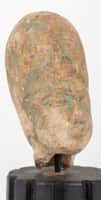 |
Pharaonic Terracotta Head Fragment With Trace Pigment. Pharaonic terracotta head fragment with traces of green pigment throughout and quite fine work. Likely Middle Kingdom. 8 x 5 x 3 centimeters and is mounted on a round fluted base for a total height of 12 centimeters. Estimated Value $400 - UP
View details and enlarged photo
Realized
$240 |
|
Lot 793 |
 |
Collection of 18 Ancient Middle East Beads. Mixed media batch of glass, quartz and stone beads of diverse styles, sizes and colors. All pierced and ready to be restrung. Estimated Value $200 - UP
View details and enlarged photo
Unsold |
|
Lot 794 |
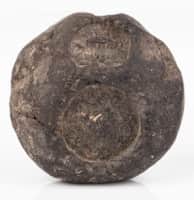 |
Sasanian Terracotta Bullae, 224-651 AD. Sealing impressions of two bullae, one depicting an animal head within ornate border, the other with two scorpions. A central void is present, resulting from the rope that was used to bind to the storage vessel. Well-preserved. Width: 35 mm. Estimated Value $200 - UP
View details and enlarged photo
Unsold |
|
Lot 795 |
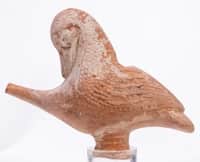 |
Tell El-YAHUDIYEH, Dark Gray Terracotta Perforated Juglet, Circa Middle Bronze Age, 1730-1550 B.C.E. Decorated with three registers of perforated triangle designs. In excellent condition, free from repairs.
Height: 6¾" On a clear Lucite stand and brass plaque. Estimated Value $300 - UP
From the Palm Desert Collection. Purchased from Superior Galleries in 1970s.
View details and enlarged photo
Realized
$324 |
|
Lot 796 |
 |
Roman, ca. 2nd-3rd century Bronze Panther-form Handle. Very appealing cast bronze handle stylized to resemble a leaping feline, with its head high, legs outstretched, and body delicately attenuated to convey both grace and speed. Rear paws are fit into an integral loop, perhaps to facilitate hanging. Forepaws are missing. Smooth green patina with earthen encrustation. Accompanied by a custom metal base that presents the piece nicely. Length: 5¼". Estimated Value $350 - UP
The Living Torah Museum, Brooklyn, NY Ex Living Torah Museum collection; ex collection of Harlan Berk, Chicago.
View details and enlarged photo
Unsold |
|
Lot 797 |
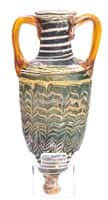 |
Roman Glass: A Green and Brown Sandcore Amphoriskos, 2nd-1st Century B.C. Of ovoid form, standing on a knop foot, with cylindrical neck and everted mouth. The body ornamented with opaque green and yellow festoons and brown handles. Yellow and cream-color spirals and trailings at neck. A magnificent piece, free from chips. Intact with minor restoration.
Height: 5¼" Housed in a custom clear Lucite case. Estimated Value $750 - UP
From the Palm Desert Collection.
View details and enlarged photo
Realized
$938 |
|
Lot 798 |
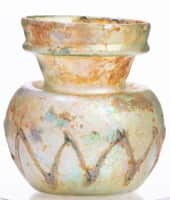 |
Roman Glass: Pale Iridescent Turquoise Jar With Green Zigzag Decoration, Circa 4th-5th Century A.D. Free from chips and cracks. A beautiful colorful jar. Height: 3½"
In a custom clear Lucite case. Estimated Value $300 - UP
From the Palm Desert Collection.
View details and enlarged photo
Realized
$408 |
|
Lot 799 |
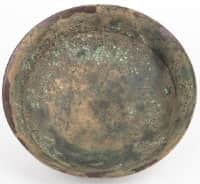 |
Sassanian Bronze Ribbed Bowl Boasting a Fine Patina. A shallow bronze bowl ca. 6th-7th CE having a ribbed body, vertical rim and rich green patina. Bowl measures slightly less than 6¾" in diameter and 2" tall. No cracks, very slight chipping of the greenish patina otherwise nice. Estimated Value $250 - UP
The Living Torah Museum, Brooklyn, NY Ex Living Torah Museum, Brooklyn, New York.
View details and enlarged photo
Realized
$175 |
|
Lot 800 |
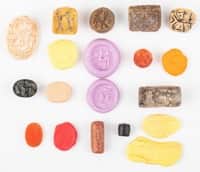 |
Collection of Near East and Middle East Bronze Age and Later Stone Stamp Seals. 11-piece collection consisting of ring seals, stamp seals and cylinder seals. Some described and most accompanied by a baked impression. A very interesting lot. Estimated Value $500 - UP
View details and enlarged photo
Unsold |
|
Lot 801 |
 |
Ancient Middle Eastern 3-piece Jewelry Group. Consists of 3rd-1st century BC items: 1.) Silver ring intaglio engraving of a male figure standing left, left hand raised, right dropping a ball into a basket? 2.) Bronze intaglio depicting a veiled female standing right holding ear of corn? 3.) Heavy solid silver bracelet with facing ibex terminals. Total of 3 items. Estimated Value $500 - UP
View details and enlarged photo
Unsold |
|
Lot 802 |
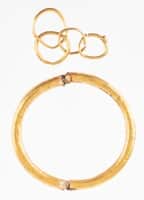 |
Gold and Bronze Child's Bracelet. Roman, 2nd-4th Century AD . Bronze bracelet plated with a thick layer of gold. Bracelet broken, with glue remnants from a previous repair. Diameter: 5.2 cm. Also includes a chain link of four solid gold loops. Total length: 4.8 cm. Estimated Value $200 - UP
Ex Goldberg 92 (July 23, 2016), lots 548 (bracelet) and 549 (chain); Ex CNG Auction 430, lot 684.
View details and enlarged photo
Realized
$120 |
|
Lot 803 |
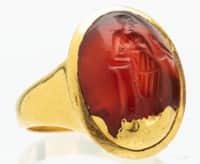 |
Authentic, Ancient, Hellenistic Carnelian Intaglio Featuring Female Figure with Owl, Likely Athena and Set in 22K Gold Ring in the Ancient Style. Outstanding carnelian intaglio from the Hellenistic period of a female figure, her arm extended with an owl perched on her hand palm up. In Greek mythology, Athena, the virgin goddess of wisdom is most associated with the owl. Intaglio has exceptional detail and has been set in a 22K hand crafted ring in the ancient style for a man, size 11½. Clay impression conveys with ring. Estimated Value $2,500 - UP
From Derek Content, London, England: Author, Dealer and Lecturer of Archeological Jewelry, ca. 1970.
View details and enlarged photo
Unsold |
|
|
|